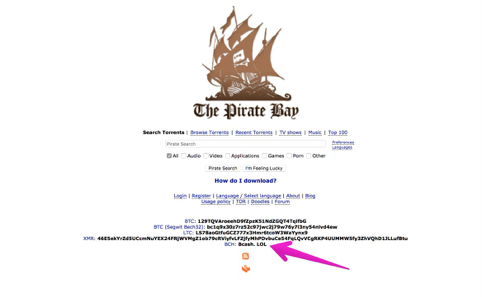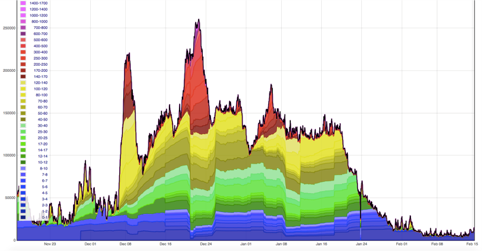Bitcoin Cash is a cryptocurrency, like Bitcoin and Ethereum, that can be used to transfer value. Together with Bitcoin’s rising popularity, it became clear that Bitcoin cannot compete with present payment solutions like Visa, which can clear 1700 transactions per second – compared to Bitcoin, which can only reach seven transfers per second.
| At eToro you can trade 49 currency pairs, including several cryptocurrencies. Join eToro |
Bitcoin Cash is an attempt to solve this problem and deliver a solution. Bitcoin Cash’s goal is to be able to provide quicker and cheaper transfers compared to Bitcoin.
The managing director of Bitcoin.com Roger Ver, often described as “Bitcoin Jesus”, is confident that Bitcoin Cash is more useful than Bitcoin:
“Bitcoin Cash has all the characteristics that attracted me to Bitcoin in the very first place”, he said. “And those characteristics are it’s fast, it’s cheap to use and reliable. And bitcoin core and their development team have intentionally made bitcoin more slow, expensive to use and unreliable. So if you have two versions of bitcoin: one that’s fast cheap and reliable and one that’s slow, expensive to use and unreliable, you don’t have to be a rocket scientist to figure out which one of those two versions of bitcoin will be most usable. And it’s clearly bitcoin cash.”, he said in an interview with CNBC.
Until Bitcoin Cash achieves a wider adoption as a payment method, it will be used by many as an asset, with hopes that over time its price will increase.
How to invest in Bitcoin Cash
The easy way
If you wish to invest in Bitcoin Cash quickly and easily, you can use a trading platform that is approved and regulated. There is a number of approved platforms, and the process to get started is easy: register as a user, send identification, and trade. However, when speculating in this way, you don’t have access to your “digital coins”. This means that you can’t pay others with Bitcoin Cash. As a speculator, this is just a technicality that does not affect your returns.
The complicated way
If you wish to invest in Bitcoin Cash and at the same time want to pay with it for products and services, which requires that you have access to your digital Bitcoin Cash “coins”, then the process becomes more complicated.
You need to be aware that you may have to trade on unregulated exchanges that have not been approved by financial regulators. This may lead, among others, to problems when transferring your profits back to your bank account. Moreover, you are not safe when it comes to hacker attacks, which have become a part of crypto-trade’s environment. If, despite this, you’ve decided to invest in this way, you should open a wallet on for example Coinbase. Then you can transfer money from your bank to the platform. The next step is to open a wallet with for example Binance, where you can trade Bitcoin Cash. Finally, you could transfer other cryptocurrencies, like Litecoin, Bitcoin, or Ethereum, from Coinbase to Binance, and use them to speculate.
Bitcoin Cash price development
Since Bitcoin Cash was created in August 2017, similarly to the rest of cryptocurrencies, it has had a number of violent price swings – from a starting price of $550 that climbed up to $4100 in December last year, only to fall to $1200 short after, in January. After a short recovery, it fell below $1000 in March, and the beginning of April saw the lowest Bitcoin Cash value in a while, around $650. At the time of writing (May 2018), the price is a volatile $1300.
These price increases and falls are a reflection of pure market forces, and Bitcoin Cash’s attempt to find its own market price in a new and volatile crypto-market.
Why invest in Bitcoin Cash?
Bitcoin Cash was born due to a disagreement within the Bitcoin community. It reflected a group of Bitcoin users who had a contradicting view on Bitcoin’s development and went their own way.
This led to Bitcoin Cash, a cryptocurrency with the goal of delivering transfers that are quicker and cheaper than Bitcoin. Technically, it has little in common with Bitcoin and its name – Bitcoin and Bitcoin Cash should be seen as two completely independent cryptocurrencies and functioning as such.
This has not, however, decreased the mud-slinging between the two camps, as hardcore Bitcoin and Bitcoin Cash supporters often end up in violent quarrels on Twitter or online forums. As a rule, Bitcoin Cash supporters claim that Bitcoin Cash is the true Bitcoin, and Bitcoin supporters are sarcastically calling Bitcoin Cash as BCash, as they think that the currency is not worth bearing the Bitcoin name.
| At eToro you can trade 49 currency pairs, including several cryptocurrencies. Join eToro |
There are countless examples of this feud. For example, the screenshot below shows Pirate Bay’s front page, which clearly shows that Bitcoin Cash is not taken seriously by their donation department.

The feud between Bitcoin Cash and Bitcoin runs deep into the crypto-world, as they touch on the most important underlying ideals of Bitcoin and the blockchain environment, namely decentralisation and usability. We’ll return to these issues, and how this discord hits them, later in the article. For now, in order to actually understand them, we must take the first step towards comprehending the technical side of the issue.
Here’s an explanation on how the technology behind Bitcoin actually functions, and what differences there are between Bitcoin and Bitcoin Cash. We will then return to understand why things turned out the way they did, this time with the chance of understanding them better.
Bitcoin Cash – technical explanation
In order to understand the issue, it is important to understand specifically how blockchain, the technology behind Bitcoin, actually functions, and how this technology handles transfers.
As it is quite complicated, we will use a train station analogy:
The best way to understand a blockchain network is to imagine a train station. One the train station (memory pool) there are passengers (transfers), who are waiting to come aboard the train (block), in order to move on (be transferred). The trains (blocks) take onboard passengers (complete the transfers), and if the size of the train (block size) is bigger, then more passengers (transfers) can happen on the train (block).
The ticket price (transfer fee) has a minimum amount, but passengers (transfers) can choose to pay more for the ticket (transfer fee), and come aboard the train (block) ahead of the queue. The bigger the train (block size), the more passengers (transfers) can come on the train.
It can be seen at all times, how many passengers (transfers) are waiting at the train station (memory pool) to come on the train (block). The route for the train (block-time) describes how often a train (block) runs from the station (memory pool). The passengers (transfers) can find, that despite their presence on the station (memory pool) they can’t come onboard the train (block), as it is full, and thus they have to wait for the next one.
The electricity on the train network (hash rate and difficulty) affect the train speed, while the conductor (protocol) controls the train’s speed and the arrival times at the station (memory pool). If one were to take a picture of the station (memory pool) at any given time, it would look like this:

In a network like Bitcoin, there is no single central actor that approves the transfers, but rather thousands of helpers (miners) help to complete the transfers. In fact, the train (block) is owned by these helpers (miners). When more and more passengers (transfers) are beginning to arrive to board the train (block), it is vital for the network to be constructed in a way that can handle increases in traffic. In blockchain terminology, this is called “scalability”.
Scalability
Scalability means that the network continues to function when experiencing increased usage. Being able to function as a real alternative to current payment systems is an important part of a cryptocurrency. The ability to handle more and more users is essential. And at the same time, it should also be competitive when it comes to transferring time and price per transfer.
While cryptocurrencies have an advantage over the current payment system when it comes to international money transfers, they are not yet mass adopted as an everyday payment method. That is something that is intensively worked on to solve, and several systems have already bragged to have found a solution. However, there aren’t many yet that pay with cryptocurrency when they make a purchase.
Nowadays, cryptocurrencies still make the most sense as assets or with international transfers. Bitcoin has drastically gained in popularity in recent years, and thus the network has gotten more and more transfer requests. The network had difficulties keeping up, and therefore the waiting time for a transfer became longer.
Current payment solutions like Visa can transfer 1.700 payments per second. If Bitcoin were to compete with it, it would have to update the way the network functions, as presently it can only clear 7 transactions per second. It had then become clear for all within the Bitcoin environment, that something should be done. However, a disagreement arose on exactly what “that” should be.
The majority of the Bitcoin community chose a solution called SegWit, but a smaller part disagreed with it, as they would’ve rather solved the problem by increasing the block size. This group chose to break away from Bitcoin, and create Bitcoin Cash.
| At eToro you can trade 49 currency pairs, including several cryptocurrencies. Join eToro |
Bitcoin’s solution: SegWit
The major part of the Bitcoin community suggested SegWit, whereby the information that came with every transfer would be reduced. Thus leaving more space for more transactions on each block, which in turn would lead to quicker transfers.
Let us use the train analogy to explain:
In the past, if they wanted to be allowed on the train (be transferred), every passenger (transaction) had to have a backpack (signature) that they would bring with them on the train (block).
Now, a conveyor belt (SegWit) has been built for the backpacks (signatures), so that one could hand in their backpack (signature) at the entrance of the station (memory pool), and the conveyor belt (SegWit) would ensure that it comes out. The passengers (transfers) no longer have to bring their backpack (signature) on the train (block). There is space for more passengers (transfers) on the train (block) now, as the backpacks (signatures) no longer take space, but are instead transported separately on the conveyor belt (SegWit).
Bitcoin Cash’s solution: bigger blocks
A smaller part of the Bitcoin community was against the SegWit solution and would have much rather solve the scalability problem by upgrading the block size from 1MB to 8MB, thus allowing for more transactions in each block, which would naturally lead to faster transfers for everybody.
If we jump back to our train analogy once again, it could be explained in the following way:
If the train (block) is bigger, then more passengers (transfers) can come on the train (be completed).
Decentralisation and usability
Eventually, the two groups had to split up and go their separate ways. This was due to the fact that, as said earlier, this disagreement touched upon central issues and values absolutely fundamental to the Bitcoin community. The first value being decentralisation, and the second concerning Bitcoin’s usability.
Decentralisation issue
Decentralisation is fundamental for the community, as Bitcoin is seen by many as a guardian against the misuse of power and market manipulation, which they believe to have seen central banks do in the last decades. The very way that blockchain technology was created is an attempt to build a decentralised network. No single central actor makes all the decisions, but rather the network itself – those who participate, decide. On the one hand, some parts of the community consider Bitcoin Cash to be more centralised than Bitcoin, because of their solution to improve scalability by increasing the block size.
In order to understand their argument, we can yet again refer to our train analogy:
Increasing the size of the train (block) makes each train (block) more expensive. This means that only big groups of helpers (miners) are able to deliver the kind of power (computer power) required to run bigger trains (mine bigger blocks). And thus, the power lies in fewer hands.
It can be seen then that the helpers (miners) have a say in regards to development, as cryptocurrencies are dependant on those who run them (mine them).
Therefore, the helpers (miners) have a say in the decisions made about an individual cryptocurrency (for example, Bitcoin). This is due to the fact that decisions are made in the form of a consensus within the community behind an individual cryptocurrency, as well as the fact that the involved parties are depended on each other.
On the other hand, Bitcoin Cash supporters consider Bitcoin’s SegWit to be a more centralised solution, as part of the transaction information on the SegWit network is not stored on the blockchain itself. The use of this solution is then considered to be less open and decentralised, as not everybody has access to the information (as it’s no longer stored on the blockchain itself).
Our train analogy can once again help in understanding this position:
Before the go on the train (block), passengers (transfers) leave their backpacks (signatures) to be transported separately. But instead of an actual train that runs on the train tracks (the blockchain), the backpacks (signatures) are carried on a conveyor belt (SegWit).
Usability
Overall, the usability question seems to ask whether Bitcoin should be a “gold standard” in the cryptocurrency world, or whether it should handle small transactions – such as buying something in a kiosk or a store. As a “gold standard” Bitcoin would be seen as a store of value, same as when people invested in gold, but not as an everyday payment/transfer method – in the same way that you would never pay with gold for your purchases on a daily basis.
Nowadays, Bitcoin seems to have found a solution (that we will come to later) that allows it to be used for small payments and transfers, but at the time of Bitcoin Cash’s creation, this possibility was not as visible as today.
Therefore, since its birth in August 2017, Bitcoin Cash was seen by its supporters as a contender against the remaining part of Bitcoin environment, believed by them to lack focus on usability when it comes to smaller transactions. Thus, both Bitcoin and Bitcoin Cash have taken steps towards developing their competitiveness, increasing speed and reducing the transfer fee for each payment, but each chose a different way.
The disagreements between the two groups were so great, that eventually, they ended up in an irrevocable split, which was implemented with a so-called hard fork.
Hard fork solution
A hard fork is a division of an existing cryptocurrency (Bitcoin) into 2 new cryptocurrencies (Bitcoin and Bitcoin Cash), where both of the following chains are two independently functioning cryptocurrencies. After the hard fork, they have nothing to do with each other, and each functions on their own blockchain.
Our train analogy can explain it thusly:
Since there is disagreement about the train service (use of the blockchain), one group chooses to open a new station, with its own train track (blockchain), and its own trains (blocks).
The scalability problem has been attempted to be solved in two different ways, namely Bitcoin’s SegWit solution, and Bitcoin Cash’s bigger blocks solution. But the development didn’t stop here.
Since Bitcoin Cash came into the world, there has been a new attempt to deal with scalability – Lightning Network. It incorporates Bitcoin’s SegWit update and functions on it.
Lightning Network
Lightning Network works by opening payment channels between different users that only need to be registered on the blockchain when they open and close.
When a payment channel is open, it must be registered on the blockchain. But it may also be possible for participants to transfer value back and forth, without having to store it on the blockchain when the channel is first opened. When these participants decide to close their balances once and for all, then it must be registered on the blockchain. In this way, it is then possible to complete a great number of transactions, without straining the blockchain on the way.
What’s is especially clever in the Lightning Network is the fact the not all participants have to open a direct channel between each other if different stakeholders can link to one another via other people, the transfers can be completed outside of the blockchain. In principle, this way would allow for thousands of transactions, which can work via the open channels on the Lightning Network. All this without having to register them: as said, they must be registered on the blockchain when the channel is opened, and when it is closed.
This leads to the possibility of an almost endless transaction, without putting a strain on the blockchain network. In this way, Bitcoin can avoid upgrading their block size, as they would no longer have a need for it.
If the network achieves mass adoption (which is already well on the way), Bitcoin Cash’s bigger block solution may prove unnecessary. It may also turn out that Bitcoin’s SegWit solution, after the introduction of the Lightning Network, was, in reality, a better choice.
| At eToro you can trade 49 currency pairs, including several cryptocurrencies. Join eToro |
To understand this correctly, let us go back to our train analogy:
We have talked earlier, that if a train station (memory pool) opened a conveyor belt (SegWit) to transport passengers’ (transfers’) backpacks (signatures), the trains (blocks) would be filled less, and there would space for more people at a time. Let us now imagine that the conveyor belt (SegWit) has been expanded and rebuilt into a metro (Lightning Network) under the train stations so that it can transport not only the backpacks (signatures), but also passengers (transactions) at the same time.
Thus, using the metro (Lightning Network), the trains (blocks) can transport the passengers (transactions) everywhere. In the future, passengers (transactions) will still have to go to the station to be registered, but once they are there, they will be able to travel back and forth between stations via the metro (Lightning Network). When a passenger decides that they are done with the metro for the day, they need to be registered again, then they move up to the train station, and check out.
It should be noted that the trains (blocks) still run, and they can be used at the same time as the metro (Lightning Network) – the passengers (transactions) must be registered on the train station, but after that they can decide themselves whether to use trains (blocks) or the metro (Lightning Network) as their mode of transport.

The future of Bitcoin Cash
Bitcoin Cash’s future is quite uncertain.
The choice of increased block sizes got Bitcoin Cash faster and cheaper transactions in a matter of seconds. But the introduction of the Lightning Network, which can only be done via Bitcoin’s implementation of SegWit, it may seem like Bitcoin may overtake Bitcoin Cash.
Recently, Microsoft has stated that they support the Lightning Network solution over block increases, as the Network allows for both quicker transactions and maintaining decentralisation on the blockchain. Bitcoin Cash is more useful for smaller, everyday transactions, and this advantage seems to have lost.
Despite this, Bitcoin Cash enjoys enormous support. Big personalities like Roger Ver, Johan Wu, and Deadal Nix are big advocates of Bitcoin Cash, and still consider Bitcoin Cash to be the version of Bitcoin that’s closest to the original idea of how Bitcoin should work.
Market developments
The question remains: how will Bitcoin Cash’s price develop in the future? As said earlier, Bitcoin is thought to overtake Bitcoin Cash on fundamental technical issues concerning transfer speed and -price. And the introduction of the Lightning Network may have a negative effect on Bitcoin Cash’s long term price development.
Lightning Networks seems to be doing well, reaching 1000 nodes in March, and reaching 2000 already in April. This means that Bitcoin becomes more attractive as an everyday payment method, and may thus give Bitcoin Cash and run for its money… or rather, cash.
However, Bitcoin cash still has a good name in many circles and has been well received on various trading platforms. Moreover, Bitcoin Cash has a far-reaching following that is thought to want to buy the currency when the price is low, which provides a good foundation for the price on the market.
Moreover, it should be remembered that Bitcoin Cash, like the other cryptocurrencies, is still strongly correlated with the price Bitcoin. Should Bitcoin’s value increase in 2018, it can be said that, to some extent, Bitcoin Cash will follow the same price trend.











